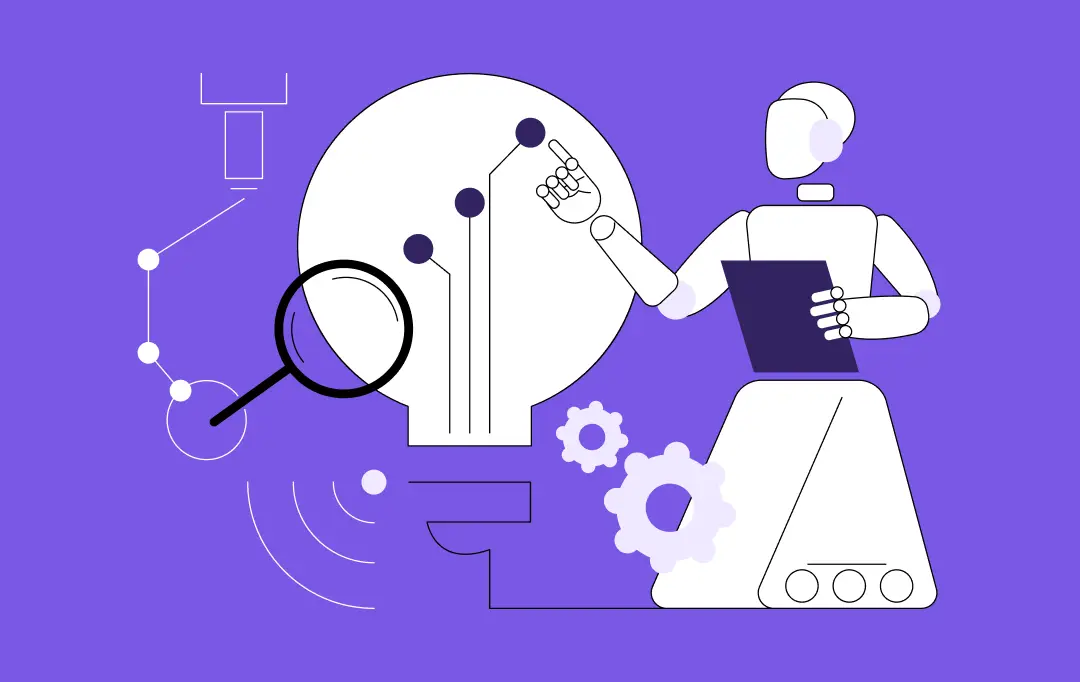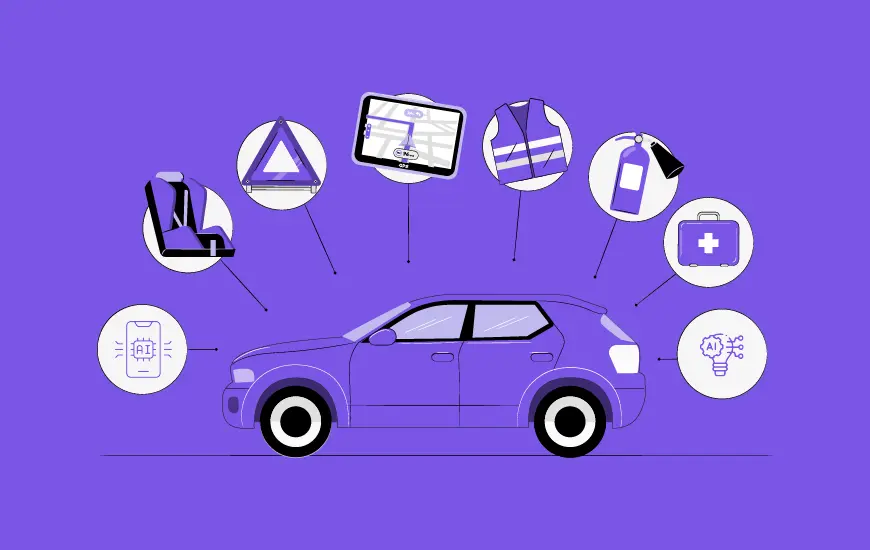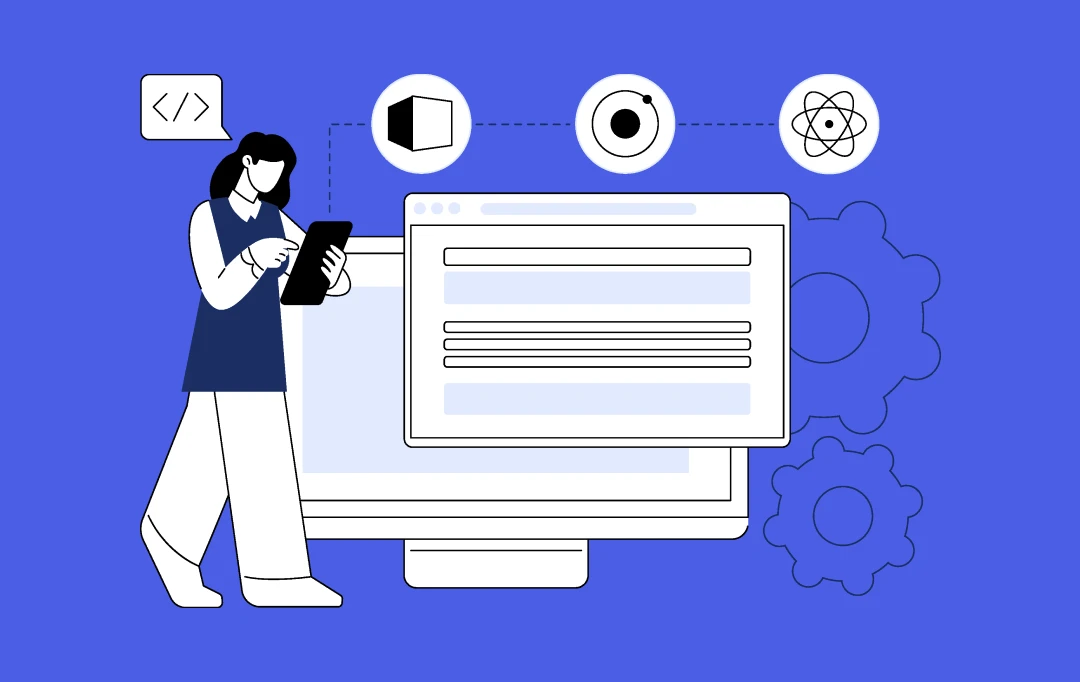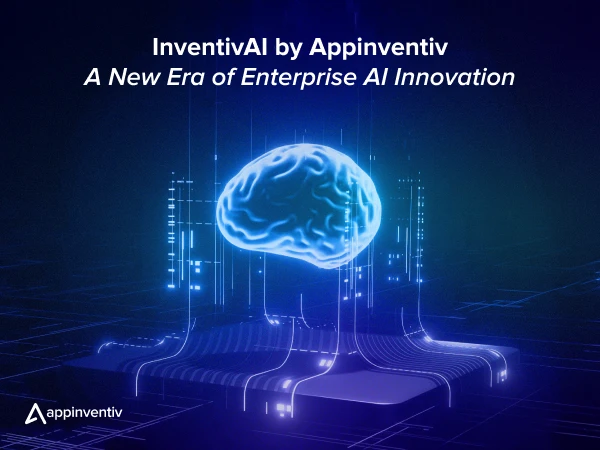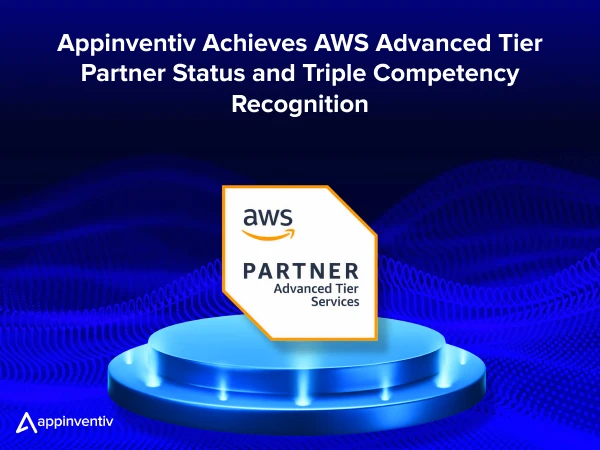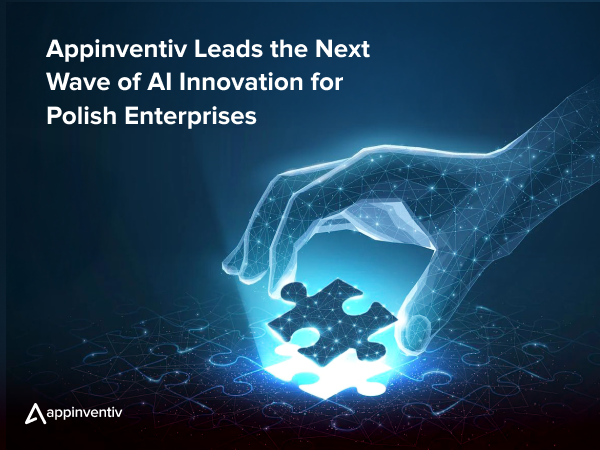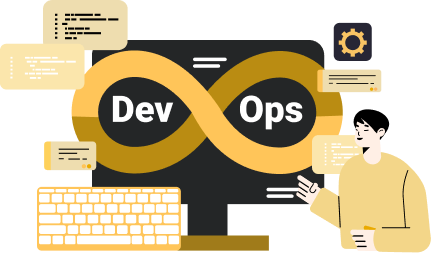- Why DevOps Matters: Understanding Its Origin and Evolution:
- Benefits of DevOps for Large Enterprises
- Cost Optimization and Smarter Resource Allocation
- Scalability Across Teams and Geographies
- Innovation as an Ongoing Rhythm, not a Single Event
- Improved Deployment Frequency and Reduced Cycle Time
- Better Operational Oversight and Risk Management
- Crucial Points Checklist for a Successful DevOps Adoption & Implementation
- Recognize Your Infrastructure Requirements
- Create a DevOps Strategy
- Choose the Right DevOps Tools
- Increase Test Automation and Align QA with Development
- Containerize Applications
- Adopt DevOps Iteratively
- Keep Feedback Continuous
- Strengthen Governance and Security
- Measure Progress and Keep Improving
- Understanding DevOps Adoption: From Small Teams to the Entire Enterprise
- Challenges in Enterprise DevOps Implementation & Strategies to Overcome Them
- 1. Overcoming the ‘Ops vs. Dev’ Mindset
- 2. Moving from Legacy Systems to Microservices
- 3. Overreliance on Tools
- 4. Lack of Ownership Over Releases
- 5. Resistance to Change
- Future of DevOps in the Enterprise Ecosystem
- How Appinventiv Helps Enterprises Put DevOps into Practice
- A Real-World Case Study
- Our Way of Working
- FAQs
Key takeaways:
- DevOps has evolved from an idea into an enterprise necessity. By 2027, nearly 80% of organizations will have a DevOps platform at the core of their delivery ecosystem.
- Successful adoption starts small: test with one team, then standardize, scale, and institutionalize DevOps across business units.
- The real gains come from culture, not just tools. Shared ownership, transparent communication, and strong leadership drive enterprise-wide impact.
- AI-Ops, platform engineering, and Green DevOps represent the next frontier, blending intelligence and sustainability into delivery pipelines.
- Appinventiv’s 1,600+ experts help global enterprises move from fragmented workflows to unified DevOps systems that cut release cycles, reduce costs, and boost team efficiency.
There was a time when DevOps was surrounded by confusion and a few myths. Today, that’s no longer the case. Most organizations now see it for what it really is: a practical way to keep up with the constant pressure for faster releases and reliable performance. With automation and cloud-native systems becoming the norm, DevOps has turned into something every IT setup eventually needs to survive.
Gartner estimates that by 2027, nearly 80% organizations will have a DevOps platform embedded in their development ecosystem. This is a sharp rise from just 25% in 2023.
Thus, for any enterprise still relying on scattered pipelines or manual processes, now is the time to step back, reassess its DevOps strategy, and start building a platform-driven foundation for the future.
However, implementing DevOps for business is not so easy. If you look back, you’ll notice how global tech companies have spent years experimenting with different ways to make DevOps work inside their ecosystems. Some found success; others didn’t.
Many teams manage to get one application running smoothly but hit roadblocks when they try to expand the same model across multiple business units. What worked in a small pilot rarely fits a global setup without some rethinking.
The bottom line is that you need a thorough strategy if you want to use DevOps to produce lasting commercial value.
In this blog, we’ll walk you through an enterprise DevOps implementation roadmap and strategies, highlight the challenges of DevOps adoption in large-scale enterprise organizations, and show how to build a collaborative DevOps culture across multiple teams, while tapping into future trends in enterprise DevOps strategy.
Consider this blog as your strategic companion for digital transformation.
Empower your enterprise with AI-led DevOps transformation before the rest catch up.
Why DevOps Matters: Understanding Its Origin and Evolution:
DevOps is not a technology, framework, or tool. Instead, it is a set of processes that aid in bridging the gap between a company’s development and operations teams. DevOps bridges the gap, removing obstacles to communication and facilitating teamwork.
DevOps also increases the efficiency of a business software delivery lifestyle by facilitating quicker software delivery, improved collaboration, and automation.
Success in DevOps doesn’t come immediately, regardless of how you define it. Instead, it is a quest. Organizations today are concentrating on raising the level of information technology delivery. When implemented properly, DevOps is essential to reaching this objective.

As you know DevOps wasn’t born out of a single moment. It came from years of trial, frustration, and a simple realization; the way we built software just wasn’t working anymore. Back in the early 2000s, developers and operations teams sat on opposite sides of the room (sometimes literally). One wrote code, the other kept the lights on, and in between them lived a never-ending pile of miscommunication, missed deadlines, and “it-works-on-my-machine” debates.
Then came 2009, a turning point. Patrick Debois, while organizing a small conference in Belgium, put a name to what many of us were already feeling: DevOps. Around the same time, John Allspaw and Paul Hammond stood on the Velocity Conference stage and showed something wild; Flickr was pushing code ten times a day. Back then, it sounded almost reckless. Now, it’s the standard we chase.
From there, the movement spread like wildfire. Teams at Amazon, Google, and Netflix picked it up early, proving that automation, transparency, and shared responsibility weren’t just buzzwords; they were the new backbone of innovation. They showed the rest of us that software could be built faster, tested smarter, and released without the weekend panic.
Today, when we talk about digital transformation in business, DevOps isn’t a footnote; it’s the foundation. It’s changed how we think about teamwork, accountability, and speed. And if there’s one thing we’ve all learned along the way, it’s this: when development and operations finally start working as one, everything else falls into place.
Also Read: How Can DevOps and Agile Integration Help Your Business Grow
Benefits of DevOps for Large Enterprises
The benefits of DevOps for large enterprises go far beyond quicker releases. It’s about how large organizations build consistency, improve visibility, and unlock innovation across complex digital ecosystems. Let’s learn the benefits of DevOps for enterprises in detail:

Cost Optimization and Smarter Resource Allocation
Automation and standardization help enterprises shift their focus from manual fixes to innovation. On average, DevOps-enabled teams spent more time improving infrastructure instead of reacting to production issues. This is a clear gain in operational efficiency.
Scalability Across Teams and Geographies
Enterprises rarely run one stack or one environment. With operations spanning multiple regions and regulations, DevOps creates a framework for consistent practices everywhere. It ensures that teams, regardless of location, follow the same playbook and deliver with predictable quality.
Innovation as an Ongoing Rhythm, not a Single Event
Perhaps the biggest shift DevOps brings is cultural. Software stops being a one-off project and becomes a continuous cycle of iteration and improvement. Enterprises can experiment, measure results, and roll out new capabilities in weeks rather than waiting for massive yearly updates.
Improved Deployment Frequency and Reduced Cycle Time
In practice, DevSecOps (a secure form of DevOps) has transformed how quickly software reaches users. A Gartner report found that nearly 50% of organizations have already adopted, 31% are at the implementation phase and 18% are discussing and planning to adopt DevSecOps in cloud driven business.

Better Operational Oversight and Risk Management
For large enterprises, knowing what’s happening across every layer of delivery is critical. With unified visibility across pipelines, teams encounter fewer unplanned outages and respond to incidents far faster. In one Gartner analysis, nearly two-thirds of DevSecOps adopters confirmed fewer security incidents and improved compliance.
Crucial Points Checklist for a Successful DevOps Adoption & Implementation
Although the idea of DevOps is not new, it has been around for more than a decade, many firms have not yet put it into practice. And some organizations still have trouble using DevOps to get the results they want. Here are the steps that will help in the successful adoption of DevOps.
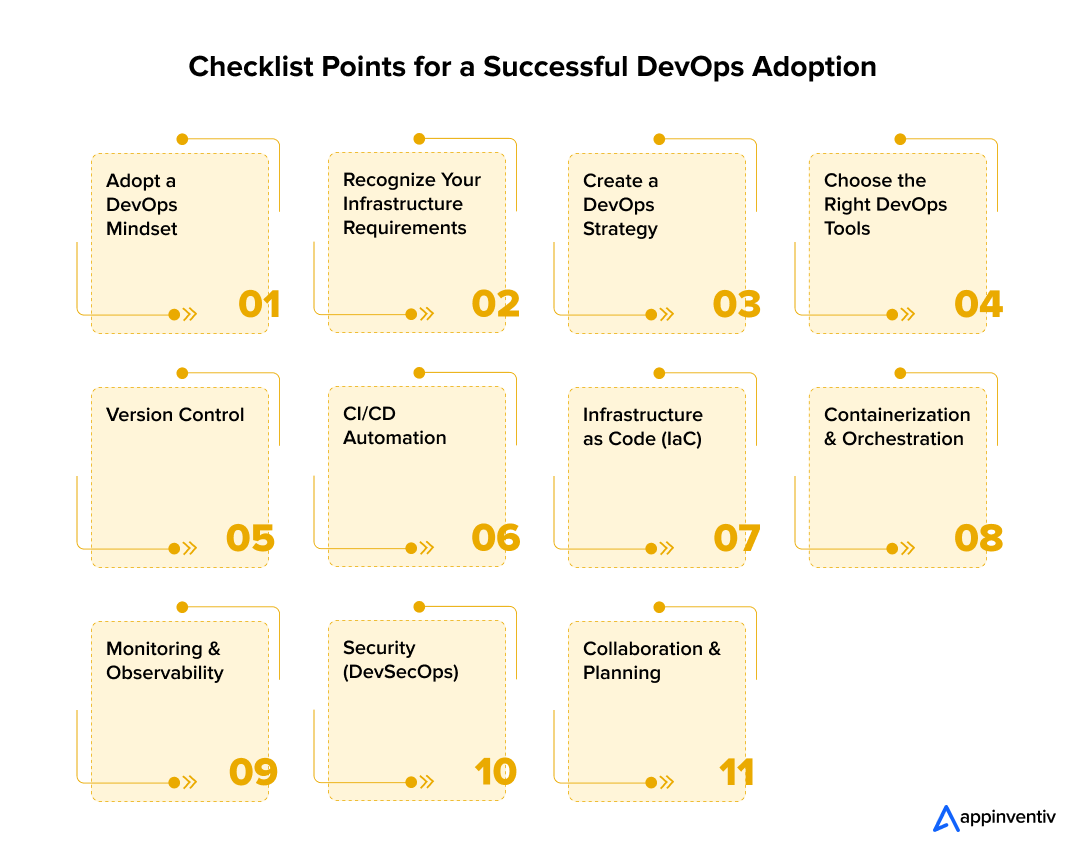 Adopt a DevOps Mindset
Adopt a DevOps Mindset
“Let’s implement DevOps”. The process doesn’t just start by saying that.
Everyone in your organization must be willing to change the way things are currently done and should have a complete sense of what DevOps is and the specific business demands it may address.
Organizations frequently mix up automation and DevOps. Even while automation helps speed up manual operations, cooperation and communication are the key objectives of DevOps. Automating your operations won’t bring about the desired business benefits unless everyone involved in the software development, delivery, testing, and operating processes adopts effective communication and collaborative practices.
The best way to implement DevOps effectively is to make sure that everyone involved in the delivery cycle is more flexible and has an innovative mentality.
Everyone participating in the process should be aware of their duties and responsibilities and trained to cooperate for DevOps to become the organization’s culture. For DevOps to succeed, the organization’s leadership must have confidence in it and help foster a DevOps culture.
Recognize Your Infrastructure Requirements
There’s no universal DevOps model. What works for a startup won’t fit a global enterprise. Thus, before jumping in, map your application architecture, delivery processes, and existing bottlenecks.
It enables you to make DevOps software development process business-driven and match infrastructure architecture with your organizational goals.
Evaluate your project delivery cycle and testing environments to find areas for improvement and possible bottlenecks.
Your DevOps adoption won’t be successful without integrating CI/CD for mobile apps pipelines into your workflow. Why? Because Continuous Delivery enables your development teams to deploy changes in production, and Continuous Integration helps them develop a product in small phases and identify and rectify faults instantly.
Create a DevOps Strategy
Program managers must establish a shared objective to bring teams together in a collaborative setting. It instills a sense of responsibility and obligation in each team member. DevOps relies heavily on best practices that promote innovative approaches to software development, architecture, and testing while enhancing teamwork.
Your strategy should be focused on two objectives: helping the team as a whole do its work to the best of its ability and facilitating the continuous operations and reliability of processes that are ready for production.
Choose the Right DevOps Tools
There isn’t a single tool that can handle all of the demands and key purposes of DevOps. The best course of action is to select a collection of enterprise DevOps tools (details later) that are ideal for the organization’s software delivery environment, applications, and teams.
The appropriate tools, guided by a DevOps maturity model, help organizations establish a solid DevOps framework, accomplish a continuous process from development to delivery, aid in resource and cost optimization, support seamless process execution, and ultimately fulfill organizational goals.

Organizations must take the following considerations into account when selecting the appropriate DevOps tools:
- The tools ought to be capable of enterprise-level automation. Without adding more effort, it will assist in scaling business workflows and continuously improving the operations.
- Integrating the entire delivery ecosystem is required in DevOps. Consequently, the tools you select should have integration capabilities.
Here is a brief table outlining the core categories and leading DevOps toolchain integrations used by enterprises worldwide:
| Category | Purpose | Popular Tools (2025) |
|---|---|---|
| Version Control | Source code management | GitHub, GitLab, Bitbucket |
| CI/CD Automation | Continuous integration and deployment | Jenkins, CircleCI, GitHub Actions, Azure DevOps |
| Infrastructure as Code (IaC) | Automate infrastructure provisioning | Terraform, AWS CloudFormation, Ansible |
| Containerization & Orchestration | Manage scalable app environments | Docker, Kubernetes, OpenShift |
| Monitoring & Observability | Track performance and reliability | Prometheus, Grafana, Datadog, New Relic |
| Security (DevSecOps) | Embed compliance and vulnerability scanning | SonarQube, Aqua Security, Snyk |
| Collaboration & Planning | Improve visibility and coordination | Jira, Confluence, Slack, Miro |
Increase Test Automation and Align QA with Development
DevOps requires appropriate automated testing in order to achieve faster delivery. Not all testing types need to be automated. For instance, manual testing should still be done for investigative, security, and usability testing. Functional testing may only be partially automated, depending on the amount of writing effort required.
Development and testing are done simultaneously to prevent bugs after a release. The recommended approach is to run automated tests 1-2 times per day while the program is still being developed. If any issues are discovered, developers can concentrate on stabilizing the software before deploying the latest build.
Containerize Applications
Application containerization is a rapidly developing technology that is altering how cloud-based applications are tested and run by developers. Your programs become lightweight and simple to execute when you containerize them.
As software is used, its reliability is increased by container packaging. Additionally, the software is independent of the broader infrastructure, thanks to its container components. This improves its ability to operate independently in any context. Furthermore, containerizing enables DevOps teams to quickly manage the application and make any adjustments required for a specific microservice.
Adopt DevOps Iteratively
Avoid attempting to launch a comprehensive DevOps in the enterprise while just getting started. Choose a pilot application and put together a cross-functional DevOps team made up of developers, testers, and operations personnel. Also, you should assess your value stream to discover bottlenecks and restrictions, and develop a preliminary deployment pipeline that takes a few of your process constraints into account.
Measure your success and growth, then repeat the process. Before starting to expand to additional projects, you must go through a few iterations to gain trust in the framework and the pilot.
Generally, you should start by addressing your largest value-stream restrictions. Some of these restrictions will be simple to overcome, while others will require a lot of time.
Keep Feedback Continuous
The one thing that separates teams that grow from those that stall is feedback. Don’t wait for big quarterly reviews. Instead, talk often after deployments, after sprints, even after incidents. Ask simple questions: What slowed us down this week? What worked better than last time?
Keep it informal but consistent. Some of the best improvements come out of five-minute hallway chats or short stand-ups where people speak freely. Over time, this habit builds trust. And when trust grows, feedback becomes honest, fast, and useful; the kind that actually changes how you work, not just how you report it.
Strengthen Governance and Security
As DevOps scales, things can get messy fast. Permissions, audits, access levels; they all start to blur. That’s why a light but clear governance structure is essential. Everyone should know who approves what, how code moves from staging to production, and where the security checks sit.
Automated scans, compliance checks, and access logs run quietly in the background, keeping you safe without slowing teams down. That’s DevSecOps in real life: less friction, more confidence, and no last-minute panic before release day.
Measure Progress and Keep Improving
DevOps isn’t a finish line; it’s a moving target. To see if you’re getting better, look at real indicators: how long it takes to deliver a change, how often you deploy, how quickly you recover when something breaks.
These numbers, often called DORA metrics, tell you where things are smooth and where they aren’t.
But don’t drown in dashboards. Use the data to start conversations. If recovery time dropped last quarter, find out why. If releases slowed, ask what’s blocking them. When teams discuss numbers openly, they stop treating metrics as reports and start using them as guidance.
That’s when DevOps stops being a project and becomes part of how the business thinks.
Understanding DevOps Adoption: From Small Teams to the Entire Enterprise
Most organizations start small, one team experimenting with automation or CI/CD and that’s smart. But scaling DevOps across hundreds of teams and multiple geographies? That’s where the real challenge begins. You’ll notice this pattern:
- Phase 1 – Pilot: A few teams adopt DevOps practices. They move fast, make mistakes, and set early benchmarks.
- Phase 2 – Standardize: Leadership notices results. You start defining templates, shared metrics, and internal best practices.
- Phase 3 – Scale: Platform engineering teams emerge. They create self-service tools, pipelines, and governance frameworks.
- Phase 4 – Institutionalize: DevOps becomes how the company builds software, not a department, but a culture.
The leap from Phase 2 to Phase 3 is where most enterprises stumble. Why? Because DevOps best practices for enterprise are less about technology and more about people, alignment, and accountability. When everyone aligns in the same direction, even legacy systems start to feel lighter.
Collaborate with Appinventiv’s DevOps consultants to unify your delivery workflows.
Challenges in Enterprise DevOps Implementation & Strategies to Overcome Them
DevOps is no longer optional for large organizations trying to stay relevant. Still, every big change comes with its bumps. The reality is, implementing DevOps at scale isn’t just a technical shift; it’s a cultural one. Some teams get stuck early, while others struggle later as systems grow. The key is spotting the hurdles before they slow you down. The following are the major DevOps adoption challenges enterprises face:
1. Overcoming the ‘Ops vs. Dev’ Mindset
For most companies, this is where the first cracks show up. Developers and operations teams often work in different worlds; one focused on shipping fast, the other on keeping things stable.
The challenge: That gap creates friction, delays, and a lot of “us vs. them” thinking.
The fix: Get both groups in the same room early. Let them share goals, review metrics together, and understand each other’s pain points. When they plan, test, and release as one team, the walls start coming down naturally.
2. Moving from Legacy Systems to Microservices
Legacy systems are heavy. They’re hard to scale, hard to patch, and make every small update feel like a risky operation.
The challenge: Monolithic setups limit speed and flexibility; one small change can break everything.
The fix: Move toward microservice architecture bit by bit. Break big systems into smaller, manageable parts. Containerize what you can and modernize what makes sense. Over time, you’ll see faster updates, fewer failures, and easier recovery when something breaks.
3. Overreliance on Tools
Every few months, there’s a new “must-have” DevOps tool. The temptation to grab them all is real but that’s where many teams stumble.
The challenge: Too many disconnected tools add more work, not less. People waste time learning features they’ll never use.
The fix: Pick tools that fit your workflow and integrate with what you already have. Fewer tools, better connected, always beat a scattered toolbox. And remember, tools don’t replace communication; they just support it.
4. Lack of Ownership Over Releases
This one’s easy to miss. In some setups, developers write code, throw it over the wall, and expect operations to handle the rest. When something breaks, no one feels responsible.
The challenge: Split ownership leads to confusion and delays when issues pop up in production.
The fix: Share responsibility. Let developers join deployment calls, review incidents, and see the impact of their work in real time. Once both sides start owning the full release cycle, delivery speed and trust go up.
5. Resistance to Change
Not everyone welcomes new ways of working. For some, DevOps feels like another buzzword that might fade; for others, it feels risky.
The challenge: Fear of change slows down adoption and divides teams.
The fix: Don’t push it as a complete overhaul. Start small; pick one product or workflow, show measurable improvement, and let success speak for itself. When teams see faster rollouts and fewer problems, support for DevOps grows naturally.
Future of DevOps in the Enterprise Ecosystem
The next phase of enterprise DevOps strategy isn’t just faster pipelines; it’s intelligent, autonomous systems that predict, adapt, and self-heal. Here’s where the future is headed for DevOps adoption and implementation in business:
- AI-Ops and autonomous delivery pipelines: AI will increasingly assist in anomaly detection, release impact prediction, deployment optimization and self-healing systems. This shifts DevOps from “automate what we currently do” to “intelligently optimize what we should do”.
- Platform Engineering Evolution: Enterprises will shift from DevOps “tool sprawl” to unified internal developer platforms (IDPs).
- Value Stream Management (VSM): The focus will move from “how fast can we deploy” to “what business value did we deliver”.
- Serverless and Edge Computing: Simplified deployment and real-time computing redefine DevOps speed and scale.
- Green DevOps: Sustainability metrics will soon join DORA metrics, measuring energy efficiency in cloud pipelines.
- Cross-Enterprise Collaboration: Multi-vendor DevOps ecosystems will emerge, integrating third-party APIs securely at scale.
How Appinventiv Helps Enterprises Put DevOps into Practice
Scaling DevOps adoption isn’t about loading your teams with new tools or demanding overnight change. It’s about teaching the organization to think differently: how to plan, build, test, and deliver as one unit. That shift has to start from leadership and flow all the way to individual contributors.
At Appinventiv, we’ve helped enterprises in 35+ different domains and 25+ countries make that shift stick. Our team of over 1,600 technology experts works with our clients to build DevOps models that fit their business reality. It’s one reason our client-retention rate stands above 97% and why global brands trust our DevOps and software development services to design delivery systems that scale without chaos.
A Real-World Case Study
Take, for instance, a mid-size financial enterprise that approached us when their product releases were dragging for weeks. Testing was manual, deployments often clashed, and operations teams were constantly in firefighting mode.
We started small: introduced automated build pipelines, rolled out containerization, and helped them embed DevSecOps checks into every release. Within months, they were releasing updates in days instead of weeks. Production incidents dropped sharply, and collaboration between engineering and ops improved enough that post-release handoffs became almost invisible.
What made the difference wasn’t just automation; it was a change that the company saw in following ways:
- 42% faster release cycles through automated builds and deployments.
- 68% reduction in post-release defects thanks to continuous testing.
- 30% cost savings from reduced manual work and better resource allocation.
Our Way of Working
We don’t sell a pre-packaged framework; we co-create one with you.
- We begin with a maturity audit to find where delays, silos, or process gaps exist.
- We build a phased roadmap, balancing technology, people, and culture.
- We align DevOps metrics like lead time, deployment frequency, change failure rate with your core business KPIs.
- We leave your teams trained, independent, and confident to evolve the system themselves.
Whether you’re introducing DevOps for the first time or scaling it across dozens of products, our DevOps implementation services stay the same: create a delivery engine that’s reliable, measurable, and ready for growth. In case you also need help for similar services, contact our experts today!
FAQs
Q. When shouldn’t you implement DevOps?
A. Warning signs when DevOps may not be appropriate include:
- Regular releases are not necessary for your company.
- Your company is happy with the software as it is right now.
- You work in a heavily regulated sector.
- There will be a lot of M&A activity in your company.
Q. How do I assess if my organization is ready to scale DevOps from applications to enterprise-wide?
A. You should start by looking beyond technology. Your readiness isn’t about tools, it’s about maturity, culture, and structure. If you already have a few application teams running successful CI/CD pipelines, that’s a great sign. But true readiness comes when:
- You have executive sponsorship that understands DevOps as a business strategy, not an IT project.
- Teams are comfortable with shared ownership of outcomes, not just deliverables.
- Metrics are transparent and consistent across teams
- You’ve started to standardize infrastructure and automation through a central platform or playbook.
If these boxes are ticked, your organization is ready to move from “DevOps teams” to a DevOps organization one where speed and stability scale together.
Q. What are the emerging trends shaping enterprise DevOps in the coming years?
A. If you’ve been following DevOps over the past few years, you’ve probably noticed it’s no longer just about speed; it’s about intelligence and sustainability. Here are some emerging trends taht shape enterprise DevOps:
AI-Ops is one big shift we’re watching closely. Picture this: instead of engineers digging through logs at 2 a.m., an AI model predicts the failure before it happens and fixes it automatically. It’s no longer science fiction; enterprises are already testing these systems.
Then there’s platform engineering, which simplifies life for development teams by offering pre-built, self-service environments. Think of it as giving every engineer a ready-to-use toolkit without compromising governance.
And of course, the multi-cloud native DevOps is here to stay. Most large companies now run workloads across several cloud providers and on-prem systems. The future of DevOps lies in stitching all those environments together — securely, efficiently, and sustainably.
As these trends evolve, we’ll see DevOps becoming less of a “departmental function” and more of a quiet, reliable foundation; the thing that keeps your entire digital ecosystem running smoothly.
Q. How much does it typically cost to implement DevOps across an enterprise?
A. Implementing DevOps across an enterprise is not a one-size-fits-all approach. It is one of those investments that keeps paying you back long after the project’s done.
For most mid-to-large organizations, the cost can range anywhere between $40,000 and $400,000 or more, depending on scale, existing infrastructure, and how many teams you’re onboarding.
Here’s how the spending usually splits:
- Tools and Infrastructure (25–35%) — CI/CD, automation, monitoring, and cloud services.
- People and Training (20–30%) — hiring DevOps specialists or upskilling internal teams.
- Platform Engineering Setup (15–25%) — creating a reusable internal developer platform.
- Change Management (10–15%) — workshops, governance models, and cultural transformation.
In terms of timeline, you can expect 6 to 18 months for full DevOps adoption. The early phase feels like time consuming, pilots, process alignment, culture change, but once the pipelines are humming, the returns show up fast.
We’ve seen enterprises cut deployment time by over 50% within the first year and reduce incident recovery time dramatically. So yes, it’s a commitment but one that reshapes how your entire organization moves.
Q. What is DevOps adoption and why is it important for enterprises?
A. DevOps adoption is a way of working that brings development and operations teams together around one shared goal, delivering software that’s faster, safer, and more dependable.
For enterprises, it’s a direct path to agility. In a world where markets change quickly, slow release cycles can hold you back. DevOps helps break that cycle. It shortens delivery times, improves quality, and keeps systems aligned with security and compliance needs.
At Appinventiv, we’ve seen enterprises cut deployment times by nearly half and reduce production downtime dramatically after adopting structured DevOps practices. The outcome is always the same: smoother collaboration and stronger digital resilience across teams.
Q. What are the key steps in moving from application-level DevOps to enterprise-wide adoption?
A. Here’s a simple path most successful enterprises follow for DevOps adoption:
- Begin with one pilot. Pick a product or project where you can test DevOps principles and see early wins.
- Document and standardize. Once the pilot works, build templates and frameworks that other teams can reuse.
- Set up a platform engineering function. This team provides common tools, pipelines, and guardrails for security and automation.
- Unify your tools. Eliminate duplicate platforms and ensure visibility across every environment.
- Agree on shared metrics. Make sure every department tracks success using the same performance indicators.
- Train and support teams. Tools can be bought but culture has to be built. Help people adjust to new ways of working.
Q. Which metrics should you track for successful DevOps implementation?
A. Tracking progress is essential, and the DORA metrics are a proven starting point. They measure your software delivery timeline based on the below metrics:
- Deployment Frequency
- Lead Time for Changes
- Change Failure Rate
- Mean Time to Recovery (MTTR)
Alongside these, it’s smart to track business outcomes on the aspects like customer satisfaction, release predictability, and the cost of downtime.
When we work with enterprises, we use these numbers to connect technology performance with business value. It’s how we help leaders see progress not in commits or builds, but in real results.
Q. What cultural changes are required for DevOps implementation at scale?
A. The toughest part of DevOps is changing how people think and work together. Here’s what that looks like in practice for successful enterprise DevOps implementation:
- Form cross-functional teams that bring developers, QA, operations, and security into one conversation.
- Replace finger-pointing with blameless retrospectives focused on fixing, not faulting.
- Help leaders shift from “command and control” to “coach and guide.”
- Recognize and reward collaboration as much as speed.
At Appinventiv, we’ve noticed a clear pattern: the biggest improvements happen when teams stop seeing DevOps as a project and start living it as a habit. Once that mindset takes root, efficiency follows naturally.


- In just 2 mins you will get a response
- Your idea is 100% protected by our Non Disclosure Agreement.

Transforming Private ROSA Deployments with Automated Tekton CI/CD
In today’s cloud-native world, application teams seek automation, security, and scalability without trade-offs. Red Hat OpenShift Service on AWS (ROSA) delivers a managed Kubernetes experience with enterprise-grade features. But when clusters run in private subnets for security, it creates a common challenge: how do you enable CI/CD pipelines that rely on external triggers, like GitHub…
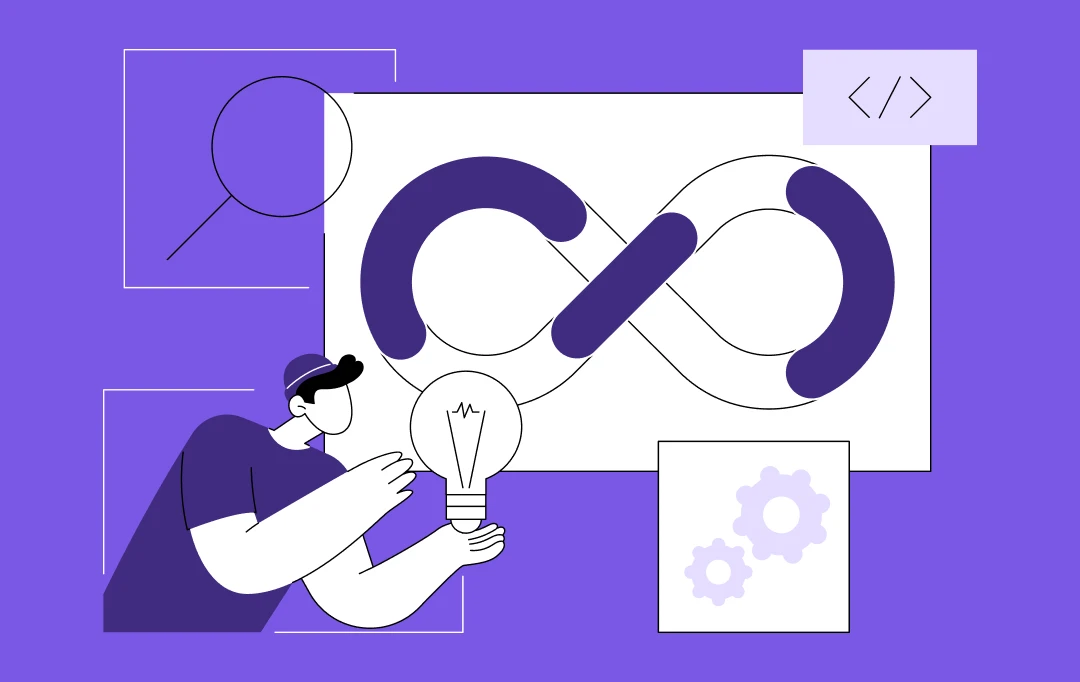
DevOps Maturity: Why It Matters and How Business Leaders Can Achieve It
Key takeaways: DevOps maturity is a business growth driver—not just a tech upgrade. Organizations evolve through five stages, from ad-hoc practices to AI-driven automation. Mature DevOps teams excel in automation, collaboration, observability, and security. Strategic frameworks like CALMS, DORA, and VSM guide transformation effectively. Achieving maturity requires cultural shifts, skilled teams, and continuous measurement. The…

Why DevOps Outsourcing is the Smartest Move for Enterprises and How to Get it Right?
Enterprise IT teams today are under siege. Market demands are shifting faster than ever, customer expectations are sky-high, and the pressure to deliver secure, high-quality software at speed has never been more intense. But here’s the kicker - most in-house teams are stuck firefighting legacy infrastructure issues, managing complex toolchains, and navigating organizational silos that…

